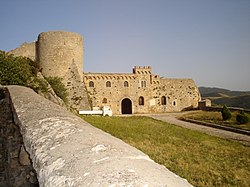Bovino
Bovino | |
|---|---|
| Comune di Bovino | |
 Romanic castle of Bovino with Norman Tower | |
UTC+2 (CEST) | |
| Postal code | 71023 |
| Dialing code | 0881 |
| Patron saint | Maria SS. of Valleverde |
| Saint day | August 29 |
| Website | Official website |
Bovino is a
Located within the woody Daunian Mountains as a terrace over the Tavoliere plains, Bovino is one of I Borghi più belli d'Italia ("The most beautiful villages of Italy").[4]
History
Bovino has more than two thousand years of history, and in 323 BC, participated in the
In 663, after being conquered by the Lombards, Bovino was destroyed during the war with the Byzantines. In 876, after the Byzantine reconquest, the walls around Bovino were rebuilt by Emperor Basil I, and the streets were laid out in their characteristic narrow design. In the 11th century, during the Norman conquest of southern Italy, Bovino was one of the last remaining Byzantine strongholds. In 1656, bubonic plague killed the majority of the local population, and only 1,200 people survived.
Main sights
The largest single edifice is the Norman castle. It occupies a commanding view of the village. The courtyard is permanently open.
The villa communale is a municipal park with ponds and fountains, housing an extensive arboretum lined with horse chestnut trees.
There are several panorama viewpoints. Most are next to remains of the original Roman wall. Several streets in the historic centre are still stepped and paved with cobbles. Other ancient sights include the Roman aqueduct.
Bovino is the seat of the
As archbishop of Kraków, the future Pope John Paul II visited Bovino in 1965 together with eleven other Polish bishops. He then laid the foundation stone of what was to become the Santuario di Santa Maria di Valleverde, dedicated to an alleged appearance of the Virgin Mary. Situated part way up hill from the main SS90 trunk road to Bovino, the Santuario has become a popular pilgrimage site. Wojtyła returned as Pope in the 1980s in order to officially ratify the Marian apparition and open the church.
Events
Bovino is home to several festivals, the largest being the "Feast of August 29th". Dating back to the time of the ruling feudal Guevara family, Bovino has a fair on that day. In addition to visits by a large number of vendors, there is usually a holy procession featuring the statue of the Madonna of Valleverde. The day is also marked by an historic cavalcade.
Economy
Bovino's economy is principally agrarian. Main crops are olive oil, sunflower oil, wine and tomatoes. Family small holdings have increasingly given way to
Of increasing importance is tourism. As a member of the society of "Italy's most beautiful villages", Bovino is recognised for its natural environment and archeological heritage.[citation needed] There are restaurants which specialise in local food. A handful of hotels are available for tourists.
References
External links
- http://www.lastampa.it/2015/04/06/multimedia/societa/i-borghi-ditalia-KctJmvzMMXrFQTpxmF6WuJ/pagina.html
- http://www.prolocobovino.it/ Archived 2011-07-22 at the Wayback Machine
- https://web.archive.org/web/20080323101252/http://www.bovinonline.it/
- http://www.orchideedibovino.it/ Archived 2011-01-12 at the Wayback Machine
- http://www.museum.com/jb/museum?id=12547 Archived 2021-09-09 at the Wayback Machine
- http://www.borghitalia.it/html/borgo_en.php?codice_borgo=348&codice=elenco&page=1 Archived 2010-11-20 at the Wayback Machine

